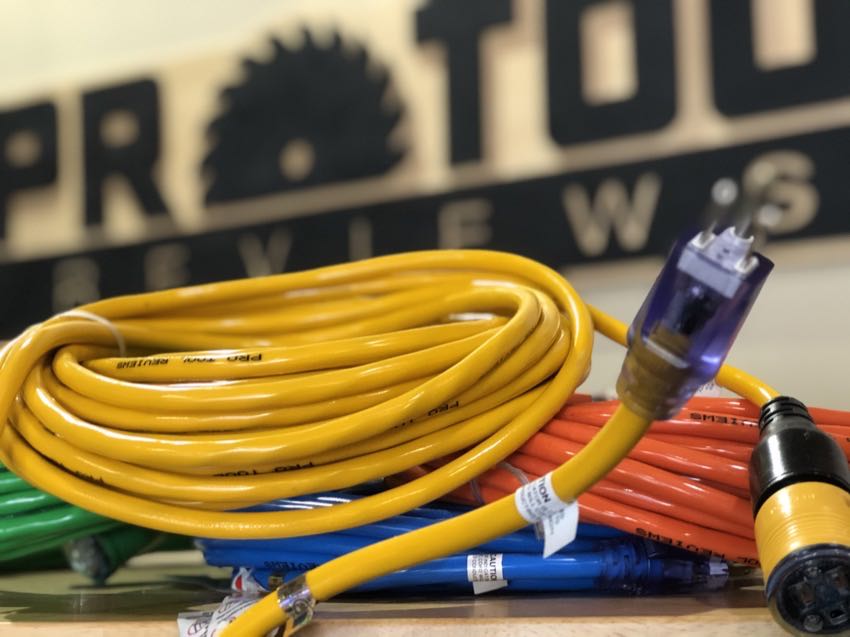After searching the Internet recently, we realized people needed a definitive extension cord size chart. Understanding wire gauge proves difficult in some situations. This chart breaks down how both the wire gauge and length of an extension cord affect its ability to convey power to a corded tool. Running a 15-amp tool? How about a full 20-amp tool? We can help you understand what length and gauge extension cord gets you and keeps you up and running.
Extension Cord Size Chart – Wire Gauge vs Length
That’s right, we’re giving you the chart right up front without making you read through paragraphs of text. If you want to know more, like what is AWG or American Wire Gauge, see below. However, if you simply want to know what gauge extension cord you need to support a particular amount of amps, or how long an extension cord you can run without losing power, here you go. Getting a firm grasp on understanding wire gauge and amps and how they interrelate can protect your tools and keep you safe.
We broke our charts down by extension cord length since that’s where most people start when looking for the right gauge cord:
100-foot Extension Cords
If you want to run a 100-foot long extension cord, you have to take into account the fact that you’re essentially creating a huge resistor. With that in mind, you typically don’t see 100-foot cords exceeding 15-amp (15A) capacity.
| Current Draw | Minimum Wire Gauge | Voltage Drop |
|---|---|---|
| 20A | 10-gauge | 4.00% |
| 15A | 12-gauge | 5.00%* |
| 12A | 12-gauge | 4.00% |
| 10A | 12-gauge | 3.33% |
*Yields a 5% voltage drop—the maximum allowed in our calculations. Consider using the next size up for anything that is at or near 5%, or—even better—opting for a shorter cord whenever possible.
50-foot Extension Cords
| Current Draw | Minimum Wire Gauge | Voltage Drop |
|---|---|---|
| 20A | 12-gauge | 3.33% |
| 15A | 14-gauge | 3.88% |
| 12A | 14-gauge | 3.10% |
| 10A | 14-gauge | 2.58% |
25-foot Extension Cords
| Current Draw | Minimum Wire Gauge | Voltage Drop |
|---|---|---|
| 20A | 14-gauge | 2.58% |
| 15A | 14-gauge | 1.94% |
| 12A | 14-gauge | 1.55% |
| 10A | 14-gauge | 1.29% |
See below for some recommendations on extension cords that should match the above requirements.
Assumptions for Sizing Extension Cord Length
For our extension cord size chart calculations, we assumed 120V single phase with a power factor of 1. We also utilized the 2014 NEC Chapter 9, Table 9 numbers for impedance and voltage drop calculations.
We also allowed for up to a 5% voltage drop—which some people might consider too high. With that being the case, only one of our recommendations hit that level, the 100-foot 12-gauge extension cord with a full 15A draw. This might be an unusual application for some, but we felt it represented a great scenario. It helps you understand what happens when using a 100-foot extension cord on a tool with a high current draw.
Why Understanding Wire Gauge and Amps Matters
Everyone on a job site or remodel has some experience with running extension cords. For larger tools that require them, it’s not enough to simply tap into the temp power pole or a nearby outlet. You have to ensure that if your tool requires 15 amps, it gets 15 amps. Use an extension cord that doesn’t carry the correct thickness (gauge) wire and you “starve” your tool.
But, you also do something worse. First, you can tax the tool motor—causing it to work harder to draw the energy it needs to run. Think of this like trying to breathe through a straw. If that straw isn’t large enough to deliver air, you struggle to breathe. That’s your tool on an improperly-sized extension cord.
Secondly, you potentially create a dangerous situation. An undersized extension cable will heat up over time. Use it in that state for too long, and the wire insulation could melt. This particularly holds true if you keep the wire in a coil, which creates resistance and a magnetic field that heats up.
Some Helpful Do’s and Don’ts
DO:
- Understand how much current you need to draw for your tool or appliance
- Properly size the wire gauge to the length and current draw required
- Keep your cables as short as possible for higher current tools
- Unroll extension cords fully so they aren’t coiled during use
DON’T:
- Use cables not properly rated for your tool and the length of cord
- Keep your extension cords coiled during use
- Use a cord that lacks a ground plug (either missing or broken)
- Run multiple high-current tools off a single cord or circuit
- Use a long extension cable if you have a short one handy
Hopefully, you found our extension cord size chart helpful and direct to the point. Understanding wire gauge and amps and how to properly size your cords for the tool and distance can make your tools last longer and run more optimally. You may also want to see our article on what kind of extension cord do I need for even more info.
Quality SJTW Extension Cord Recommendations
From The Home Depot
- RIDGID 100 ft. 10/3 Heavy Duty with Lighted End
- Yellow Jacket 100 ft. 12/3 Heavy-Duty Lock Jaw
- Southwire 50 ft. 12/3 Hi-Visibility Heavy-Duty with Power Light Plug
- Husky 25 ft. 12/3 Heavy-Duty 15 Amp with Lighted Triple Tap
Amazon
- Southwire 100 ft 10/3 Extra Heavy Duty with Lighted End
- Yellow Jacket 100 ft 10/3 Extra Heavy Duty with Lighted End
- Yellow Jacket 50 ft 12/3 Heavy Duty with Lighted End (3-Outlet)
- US Wire 25 ft 12/3 SJEOW TPE Cold Weather with Lighted Plug



